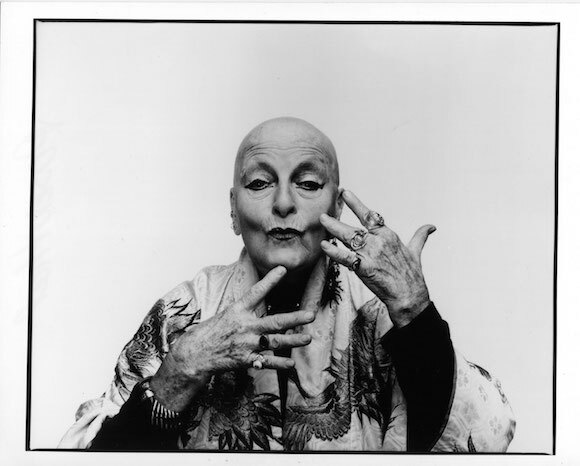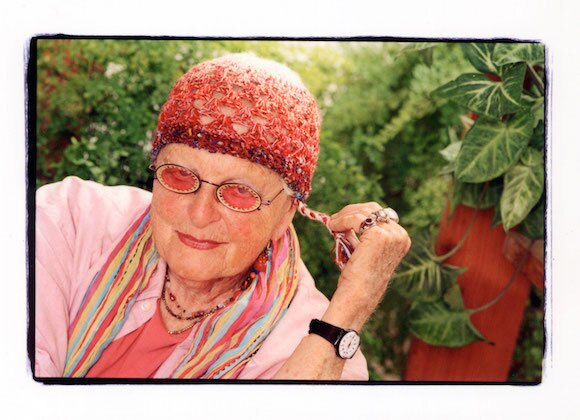Performance Artist Rachel Rosenthal Dies at 88

Performance-art visionary, animal rights activist, and avant-garde icon Rachel Rosenthal passed away from complications from congestive heart failure at 7 p.m. on Sunday, May 10, 2015, according to Kate Noonan, Rosenthal's collaborator for the past 20 years. Rosenthal was surrounded by friends of the Rachel Rosenthal Company, a non-profit organization she founded in 1989 as an outlet for her revolutionary creative vision. She was 88 years old.
Rosenthal was a colleague of the likes of Robert Rauschenberg, Jasper Johns, Merce Cunningham, John Cage, John Baldessari, Llyn Foulkes, and George Herms, but her own art was practically indescribable. It merged the seemingly disparate disciplines of dance, theater, music, and visuals into one live art form that rarely repeated itself, yet always left a lasting impression. She performed in over a hundred international venues and delivered dozens of original works that both embodied and transcended the genre of "performance art," earning her an Obie award as well as recognition from institutions such as the NEA and Getty, among others. She received an honorary doctorate from the School of the Art Institute of Chicago in 1999 and one year later, the City of Los Angeles proclaimed her a "Living Cultural Treasure of Los Angeles." But she was not just about the highbrow: Rosenthal also appeared in an episode of the NBC show "Frasier."
Rosenthal was born November 9, 1926 in Paris, France to a wealthy Russian-Jewish family who emigrated across Europe in order to escape Nazi persecution during World War II, eventually settling in Rio de Janeiro. In 1941, the Rosenthals came to New York, and Rosenthal herself became a naturalized citizen and graduated from the High School of Music and Art. Even as an adult, her spoken English still bore a distinct unrecognizable accent that was the result of living in many different places as a child.
The artist moved to Los Angeles in the mid 1950s and together with her husband of 20 years, actor King Moody, she performed in the Instant Theatre, where she was also artistic director. They produced improvised performances, sowing the seeds for Rosenthal's ensuing career as an artist who worked live using movement, music, and words, effectively redefining the meaning of interdisciplinary art.
"Rachel was one of the first performance artists to introduce elements of 'theater' into her performance art pieces," says Dark Bob, a multimedia performance artist and musician, and a friend and colleague of Rosenthal's. "She was aware of her audience and 'entertaining' was important to her. Though she never compromised her topics, she was able to present herself with crowd-pleasing oratory, costume, and staging. And she developed a huge audience in spite of her politically-charged and personally revealing context. Because of artists like Rachel, performance art has vast options. It is no longer the 'only-child' of the visual arts. It has become adopted by choreographers, comedians, writers, and musicians."
In 1980, Rosenthal opened her own studio Espace DbD on Robertson Boulevard and featured works by both established and emerging performance artists. Through her educational non-profit arts organization the Rachel Rosenthal Company, she began offering extended performance art workshops to teach her methods to younger artists who yearned to acquire a more artistic approach to improvisational theater that served as both a creative outlet and curious kind of personal art therapy for its practitioners.

In 2010, Routeledge published Rosenthal's book The DbD Experience: Chance Knows What It's Doing. Equal parts manifesto, memoir, and manual, it unveiled the meaning of DbD, which is an acronym for Rosenthal's creative formula: "doing by doing."
That same year, Rosenthal debuted the TOHUBOHU! Extreme Theater Ensemble, its name taken from a French word meaning "commotion," which evolved from a Hebrew term meaning "without form and void," the time before God said "Let there be light." Under Rosenthal's direction, the improvisational group presented unique performances in which the use of choreography, sound, improvisation, costumes, lighting and props were at the mercy of chance and the players' own impulses. At these one-of-a-kind shows, Rosenthal would sit in the front row of her intimate theater and conduct the actors as though they were playing musical instruments, but instead of making music, they'd create a type of off-the-cuff tableau vivant in which Rosenthal's own dogs would sometimes wander in from backstage and become part of the work, too. Text and narrative were substituted by the members' own unexpected and often subconsciously-driven actions, creating a type of composition that unfolded according to the players' own actions and reactions to themselves and others.
"Chance is the core of improvisation," Rosenthal once described TOHUBOHU!, "It's about breaking down borders, opening up to the givens, activating the moment, and paying attention to what is."
According to Noonan, Managing Director of the Rachel Rosenthal Company, Rosenthal taught her last workshop the Tuesday night before her death, and is survived by her nephew Eric Landau and her dog Fanny. The interdisciplinary artist left a profound and lasting impression on all those who knew her, worked with her, had the pleasure of seeing her perform, and/or saw her direct one of her shows.

"Her non-profit organization, the Rachel Rosenthal Company, will continue her legacy by teaching her methods and performing once a month in the studio," Noonan writes. "Immensely proud of the work of her current ensemble, Rosenthal recently said that this version of her company has made her dream of theater fully realized, keeping her going for the last years of her remarkable 88 years on the planet."
Meanwhile, art critic Shana Nys Dambrot says, "What's truly remarkable exists not only in terms of what she did accomplish in her own career and throughout her own movie-worthy life story. All the boundaries she broke, from genre to gender, this is the story -- but perhaps even more remarkable still is how fresh and salient and vibrant her work and her techniques remained for subsequent and current generations of interdisciplinary artists. There are people who were born after she was on "Frasier" who owe their maturing voices to her right now -- and who know this and sought her out. That's rare and wonderful, and that is how we know her legacy must live on."
A public memorial service for Rachel Rosenthal is currently being planned.
WATCH: Rosenthal appears in Artbound's throwback episode, "Earthworks." Her performance starts at the 21 minute mark:



Top Image: Rachel Rosenthal by Michael Childers. | Courtesy the Rachel Rosenthal Company.
Dig this story? Sign up for our newsletter to get unique arts & culture stories and videos from across Southern California in your inbox. Also, follow Artbound on Facebook, Twitter, and Youtube.